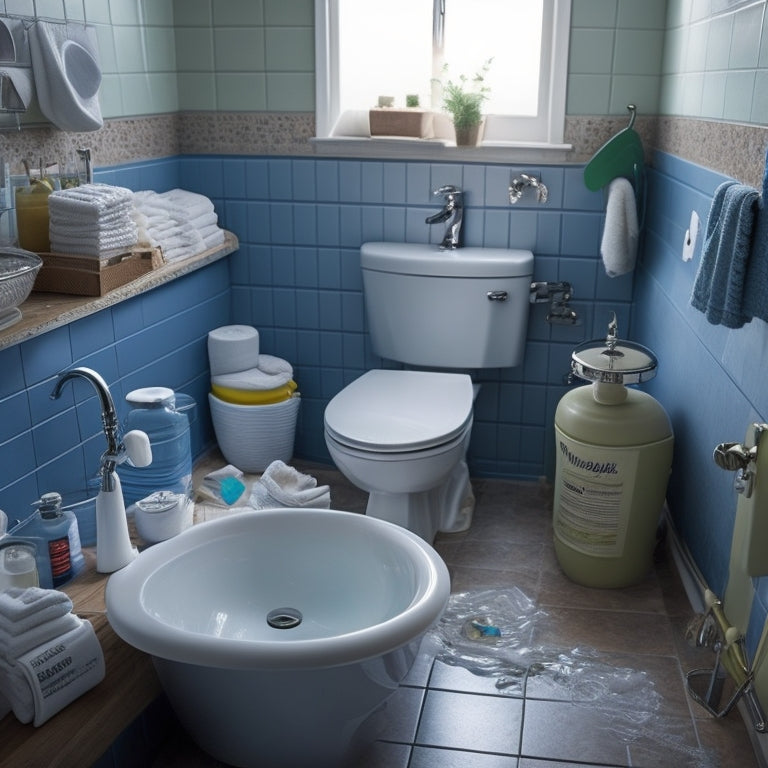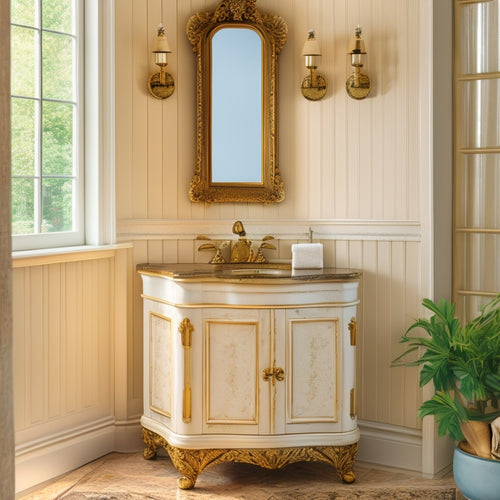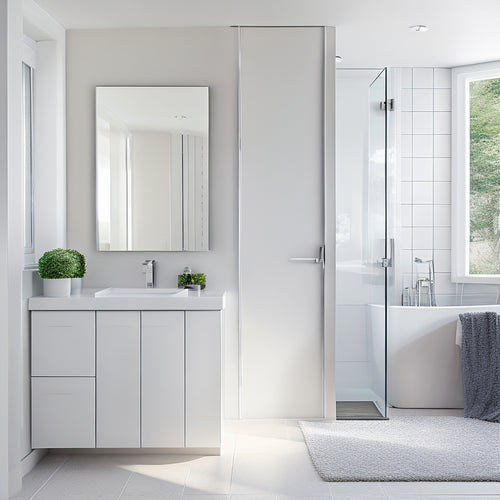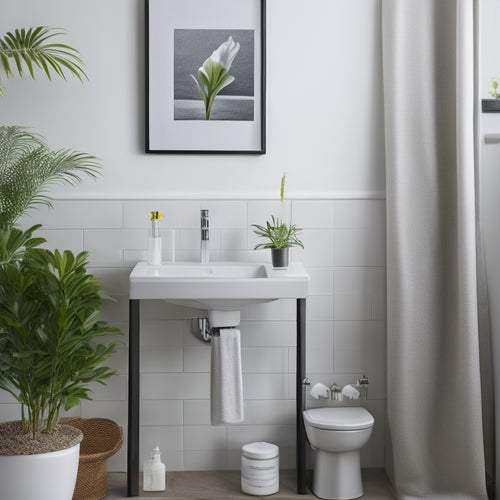
Disadvantages of a Sink Built Into a Toilet
Share
You're considering a sink built into a toilet, but be aware that this space-saving design comes with significant drawbacks. Higher upfront costs, space constraints, and reduced water pressure are just the beginning. You'll also face increased maintenance needs, a higher risk of clogging, and an inconvenient user experience. Additionally, the design may compromise health and hygiene, and the aesthetics might not appeal to you. As you weigh the pros and cons, it's crucial to understand the full scope of these disadvantages - and there's more to investigate below.
Key Takeaways
- Higher initial installation costs and space constraints are significant drawbacks of a sink built into a toilet.
- The compact design can lead to reduced water pressure, increased maintenance needs, and a higher risk of clogging.
- The proximity of the sink to the toilet increases the risk of germ spread and cross-contamination, posing health and hygiene risks.
- The unusual design can compromise user comfort and accessibility, particularly for individuals with disabilities or mobility impairments.
- The limited design options and aesthetic compromises can detract from the overall appeal of the bathroom.
Higher Initial Installation Cost
Installing a sink built into a toilet, also known as a toilet-sink combo, can be a costly venture upfront.
You'll need to take into account the installation process, which involves more than just plugging in a new fixture. A toilet-sink combo requires extensive plumbing and electrical work, which can drive up the initial cost. You'll need to hire a professional to handle the installation, and their labor costs will add up quickly. Additionally, the combo unit itself is typically more expensive than a traditional toilet and sink.
While the upfront cost may be steep, it's important to evaluate it against the long-term savings.
With a toilet-sink combo, you'll use less water overall, which can lead to significant savings on your water bill. Additionally, the combo unit is often more water-efficient than traditional fixtures, which can also reduce your environmental impact.
Space Constraints and Limitations
Configuring a toilet-sink combo in a small bathroom can be a significant challenge.
You'll face space constraints that'll make you wonder if it's worth the compromise. The combo takes up more space than a traditional toilet, leaving you with limited floor space for other essentials. You'll need to carefully plan the layout to guarantee there's enough room to move around comfortably.
In addition, plumbing considerations will affect your design. The sink's plumbing will need to be integrated with the toilet's, which can be tricky. You might need to reroute pipes, affecting the overall space efficiency of your bathroom.
This can lead to a cramped and cluttered space that's far from ideal. Moreover, you'll need to take into account the height and depth of the combo, confirming it fits comfortably in the available space.
With all these constraints, you might find yourself sacrificing comfort and functionality for the sake of innovation.
Reduced Water Pressure Issues
As you maneuver through the complexities of a toilet-sink combo, another issue arises: reduced water pressure. You might find yourself wondering why the water flow is weaker than expected. The culprit lies in the pressure regulation system, which is compromised when a sink is built into a toilet.
The toilet's water supply is typically designed to prioritize flushing power, leaving less pressure for the sink's water flow. This can result in a disappointing trickle instead of a revitalizing gush.
When you turn on the faucet, the toilet's water supply is diverted to meet the sink's demands. However, this diversion can cause a noticeable drop in water pressure. Imagine trying to wash your hands under a weak stream of water - it's not exactly the most invigorating experience.
Additionally, reduced water pressure can also affect the overall performance of the toilet, leading to subpar flushing performance. It's crucial to reflect on these pressure regulation issues before installing a toilet-sink combo to avoid a world of frustration.
Increased Maintenance Requirements
You'll need to commit to a more rigorous maintenance schedule with a sink built into a toilet, as the combined water flow and waste disposal can lead to clogged pipes and drains.
Additionally, the toilet's cleaning process becomes more complicated due to the integrated sink, requiring more attention to detail to prevent bacterial buildup and unpleasant odors.
Regular checks and maintenance will be essential to prevent these issues from becoming major problems.
Clogged Pipes and Drains
Clogged pipes and drains are a common issue with sinks built into toilets, and they can lead to increased maintenance requirements. You'll need to be prepared to deal with pipe blockages and drain backups on a regular basis. The combination of toilet paper, human hair, and soap scum can create a sticky situation (literally!) that'll have you calling a plumber more often than you'd like.
When you flush the toilet, the water flow can be disrupted by the sink's drainage system, causing clogs and backups. And let's not forget about the hair that accumulates in the sink's drain – it's like a never-ending battle! You'll need to invest in a good drain snake and some strong cleaning products to keep your pipes flowing freely.
To minimize the risk of clogs and backups, you should consider installing a high-quality drain filter and performing regular maintenance checks. This might include checking the drain for blockages, running hot water through the system, and using a plumbing-safe cleaning product to break down any stubborn debris.
Toilet Cleaning Complications
Your toilet's cleaning process becomes more complicated with a sink built into it, resulting in increased maintenance requirements.
You'll need to invest in specialized toilet cleaning products that can tackle the unique design of your sink-toilet combo. These products might be pricier than regular toilet cleaners, and you may need to use them more frequently to keep your toilet area hygienic.
The sink built into your toilet creates more crevices and corners where dirt, grime, and bacteria can accumulate. This means you'll need to clean your toilet more often, increasing the cleaning frequency.
You'll need to scrub the sink area, the toilet bowl, and the surrounding surfaces more thoroughly, which can be a real pain.
Imagine having to maneuver through the tight spaces between the sink and toilet with a toilet brush, trying not to splash water or cleaning products everywhere. It's a recipe for frustration!
With a separate sink and toilet, cleaning is much simpler and more efficient. But with a sink built into your toilet, be prepared to spend more time and effort keeping your bathroom clean and hygienic.
Unappealing Aesthetics and Design
You'll likely find that a sink built into a toilet compromises on aesthetics, resulting in an unusual toilet shape that may clash with your bathroom's design.
Additionally, you'll have limited design options, restricting your ability to customize the look and feel of your bathroom.
This unconventional design may not appeal to you or your guests, making it a significant drawback.
Unusual Toilet Shape
Beyond the functional concerns, a sink built into a toilet can also raise aesthetic red flags, particularly when it comes to the unusual toilet shape that often accompanies this design. You may find yourself wondering, "Is this toilet trying to be a sink or a toilet?" The unusual shape can be jarring, making it difficult to determine the toilet's purpose at first glance.
Toilet ergonomics suffer as a result, making it uncomfortable for you to sit or stand. The sink functionality, which is supposed to be a convenient addition, ends up feeling like an afterthought. You're left with a toilet that's neither here nor there regarding design.
Here's a breakdown of the common issues with unusual toilet shapes:
| Issue | Description | Impact |
|---|---|---|
| Unbalanced design | The sink protrudes from the toilet, creating an uneven shape. | Aesthetically unpleasing, affects toilet ergonomics |
| Confusing functionality | The sink's placement can make it unclear how to use the toilet. | Decreased sink functionality, increased user frustration |
| Limited seating space | The sink takes up space, reducing the area available for sitting. | Discomfort, difficulty using the toilet |
| Difficulty cleaning | The unusual shape creates crevices and corners that are hard to clean. | Increased maintenance, potential hygiene issues |
Limited Design Options
The unusual toilet shape that often accompanies a sink built into a toilet also raises concerns about design options. You might find that your style preferences clash with the awkward layout, making it difficult to create a cohesive look in your bathroom.
For instance, you might struggle to find a toilet paper holder or towel rack that complements the unique shape.
Moreover, user habits can be affected by the limited design options. If you're someone who likes to keep essentials like toilet paper, towels, or even a trash can nearby, you might find that the built-in sink toilet combination leaves little room for these necessities.
This can lead to a cluttered and cramped bathroom experience. In addition, the compact design mightn't accommodate users with mobility issues or those who require extra space for medical equipment.
The inflexibility of the design can be a significant drawback, especially in households with diverse needs. Ultimately, the limited design options can compromise both form and function, making the sink-built-into-toilet combination a less-than-ideal choice for many users.
Higher Risk of Clogging
With a sink built into a toilet, debris and waste can easily flow into the drainpipes, greatly increasing the risk of clogging. You might think you're being efficient with your toilet efficiency and waste management, but trust us, it's a recipe for disaster.
Here are three reasons why:
-
Hair and soap scum buildup: When you wash your hands in the sink, hair and soap scum can flow down the drain and accumulate in the pipes, causing clogs and reducing water flow.
-
Toilet paper and wipes: With a sink built into a toilet, it's easy for toilet paper and wipes to get flushed down the sink drain, which can cause blockages and backups in your pipes.
-
Food particles and grease: If you're washing dishes or food scraps in the sink, these can also flow into the drainpipes, contributing to clogs and reducing the overall efficiency of your toilet.
Inconvenient User Experience
Most users will find that a sink built into a toilet compromises their comfort and convenience.
You'll likely experience user frustration when trying to wash your hands while maneuvering the cramped space between the toilet bowl and sink basin. This setup forces you to lean forward, straining your back and neck, just to reach the faucet. Furthermore, the proximity of the sink to the toilet creates an awkward reach, making it difficult to wash your hands properly.
Additionally, user accessibility becomes a significant issue, particularly for people with disabilities or mobility impairments.
The sink's location can be challenging for those who require extra space or assistance to maneuver. The compact design might also make it difficult for you to clean the sink area, leading to a buildup of soap scum and water spots.
When nature calls, you want a hassle-free experience.
A sink built into a toilet only adds to the inconvenience, making you wonder if the novelty is worth the trouble.
Potential Health and Hygiene Risks
You're more likely to encounter health and hygiene risks when a sink is built into a toilet. The compact design may seem convenient, but it creates a breeding ground for germs and bacteria.
With the sink and toilet in close proximity, you're more prone to cross contamination. Every time you flush, bacteria and viruses can spread to the sink area, putting you at risk of infection.
Here are three potential health and hygiene risks to take into account:
-
Germ accumulation: The sink's proximity to the toilet means germs can easily spread from the toilet bowl to the sink, faucet, and surrounding areas, making it difficult to maintain a clean environment.
-
Cross contamination: When you wash your hands in the sink, you may inadvertently transfer bacteria and viruses from the toilet area to your hands, increasing the risk of illness.
-
Increased risk of infection: The compact design can lead to a higher risk of infection, particularly for people with weakened immune systems, such as the elderly or those with chronic illnesses.
Frequently Asked Questions
Can a Sink-Toilet Combo Be Installed in a Small Bathroom?
You can install a sink-toilet combo in a small bathroom, leveraging space-saving benefits, but consider plumbing intricacies, ensuring proper venting and drainage to avoid a messy marriage of water and waste.
Are Sink-Toilet Combos Available in Different Styles and Materials?
You'll find sink-toilet combos in various design options, from sleek modern to traditional, and material choices like ceramic, glass, or stainless steel, offering you a range of styles to fit your bathroom's unique vibe and needs.
Can I DIY Install a Sink Built Into a Toilet?
You can DIY install a sink built into a toilet, but be prepared to tackle installation challenges like awkward plumbing considerations and cramped spaces - it's like solving a puzzle, blindfolded, while being attacked by a swarm of bees.
Are Sink-Toilet Combos More Environmentally Friendly Than Separate Fixtures?
You're steering the waters of eco-friendliness, and sink-toilet combos are like a lifeline, offering a splash of water conservation and a hint of space efficiency, making them a practical, yet stylish, choice for the environmentally conscious you.
Do Sink-Toilet Combos Require Special Cleaning Products?
You'll face unique cleaning challenges with sink-toilet combos, requiring specialized products to tackle odor issues and grime buildup around the sink basin and toilet bowl, but don't worry, there are effective solutions available to make cleaning a breeze!
Conclusion
Considering all the drawbacks, it's clear that a sink built into a toilet isn't the best choice for your bathroom. From higher installation costs to potential health risks, the cons outweigh the pros. Did you know that 64% of households with these units experience clogging issues within the first year alone? It's time to rethink this trendy design and opt for a more practical, user-friendly solution that won't leave you dealing with a mess down the line.
Related Posts
-

Vintage-Style Freestanding Bathroom Cabinets for Classic Look
When you choose vintage-style freestanding bathroom cabinets, you're adding timeless charm to your space while maximi...
-

Contemporary Slimline Storage for Modern Bathrooms
As you envision your modern bathroom, consider the innovative potential of contemporary slimline storage. By cleverly...
-

Top-Selling Bathroom Organization Ebook - Only $0.99
This top-selling bathroom organization eBook, available for instant purchase at an unbeatable price of $0.99, provide...


